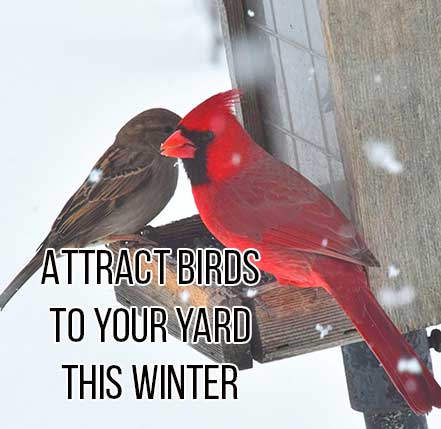Attract Birds to Your Yard this Winter
 Birds add color and life to your yard in the middle of winter. There’s nothing as striking as a pair of bright, red cardinals against the white snow. You can attract birds to your yard with the right food and feeders. Of course, you’ll also be helping them get through the winter, so you can enjoy their chirping in the spring. Here in Michigan it’s common to see House Sparrows, Chickadees, Cardinals, Woodpeckers, Mourning Doves, Bluejays, Finches, Titmice and Starlings around the bird feeders during cold months. Here are a few tips to help you enjoy birds in your yard all winter.
Birds add color and life to your yard in the middle of winter. There’s nothing as striking as a pair of bright, red cardinals against the white snow. You can attract birds to your yard with the right food and feeders. Of course, you’ll also be helping them get through the winter, so you can enjoy their chirping in the spring. Here in Michigan it’s common to see House Sparrows, Chickadees, Cardinals, Woodpeckers, Mourning Doves, Bluejays, Finches, Titmice and Starlings around the bird feeders during cold months. Here are a few tips to help you enjoy birds in your yard all winter.
1. Use large feeders or multiple feeders. The more food supply available at one time, the more birds you’ll attract at one time. Many birds also like having plenty of space to land and perch while they eat. A bigger capacity also means you’ll have to refill the feeders less often.
2. Provide the right food. A mix of black oil sunflower seeds, shelled peanuts, niger seed and white millet seed will attract most common winter birds in northern states. Bags of mixed seed can be purchased at almost any store with a lawn and garden department.
3. Provide fatty food as well. In order to stay warm, birds burn extra calories in the winter. Put suet and peanut butter out to provide the birds with high energy food. Woodpeckers especially enjoy suet feeders.
4. Keep feeders full all winter. In the winter, birds need to fill up every day with food, so they can stay warm through the cold night. They also get used to coming to a particular spot every day to eat. If you go out of town, ask a friend to keep the feeders full, so your feathered friends won’t go hungry.
5. Give them water. When all the ponds and lakes are frozen, it can be hard for birds to find water. On warmer or sunny days when it won’t freeze, put a pan or bowl of water out by the feeder.
6. Shovel or pack down snow around the feeder. Some birds, like mourning doves, are ground feeders. They’ll eat the seed that falls from the feeder if the snow isn’t too deep.
7. Hang feeders in locations safe from predators. Hang bird feeders ten feet or more away from bushes or other places cats and small predators can lie in wait. Birds will feel safer when they come to eat.
8. Clean your feeders. Without rain and with so many birds coming to the feeder, it can get dirty. Keep it clean and ensure the birds have a healthy food source by washing the feeder in hot, soapy water once a month or so.



